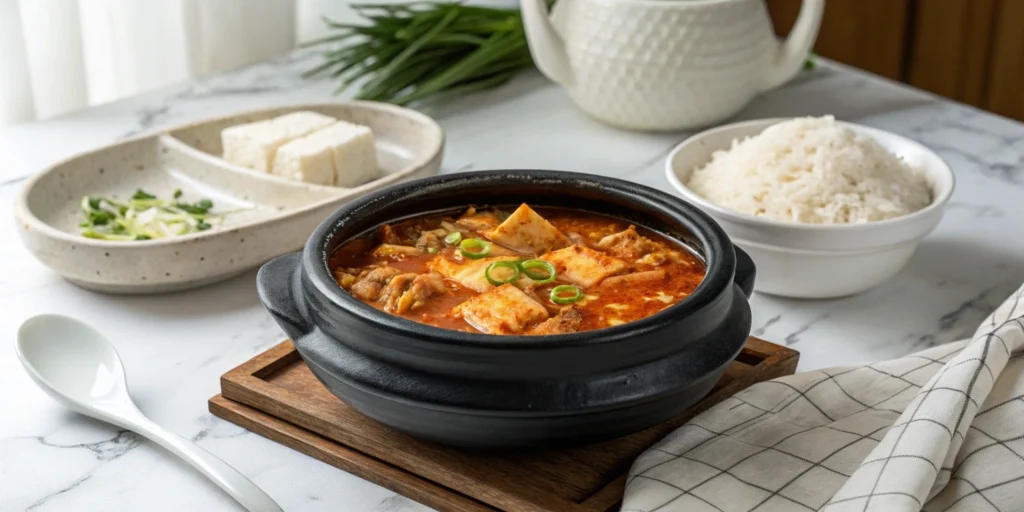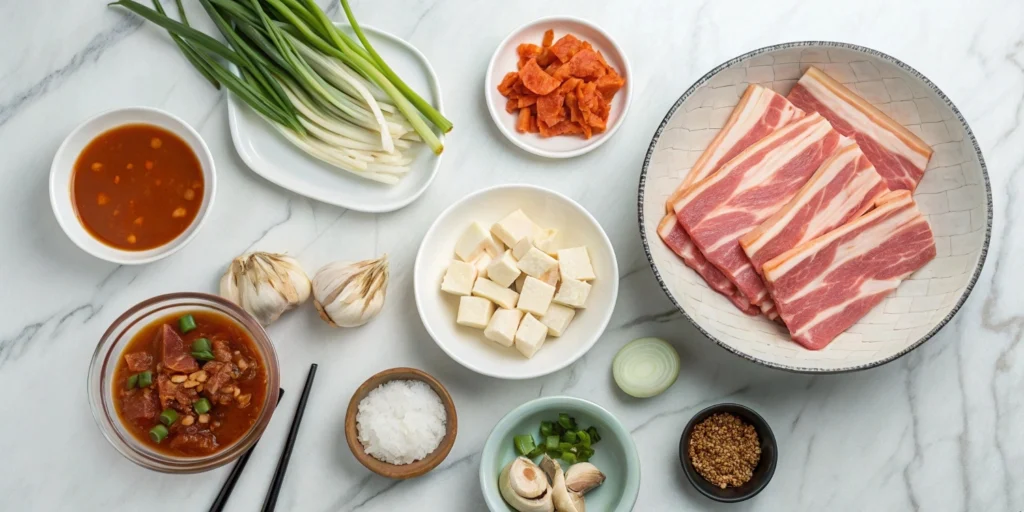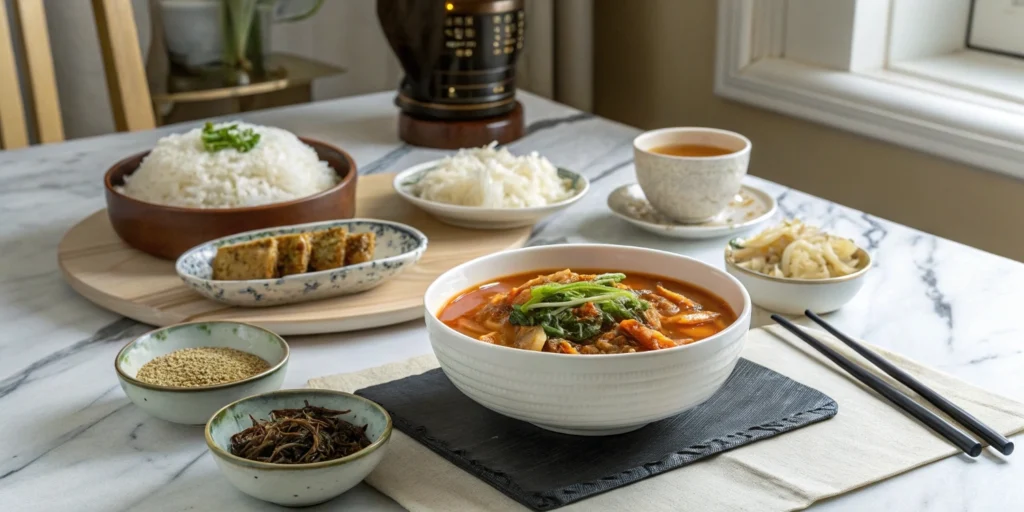
Table of Contents
Some recipes go beyond taste—they transport you. Kimchi jjigae (김치지가이) is one of those dishes. If you grew up in a Korean home, the scent alone stirs up comfort and warmth. Even if you didn’t, this stew welcomes you like an old friend. It’s more than spicy heat; it’s a bowl of depth, of soul, of heritage.
What pulls you in is not just the flavor but the feeling it brings. And the one secret that elevates this dish? Aged kimchi. It might sound simple, but that extra fermentation brings tang, funk, and character no other ingredient can replicate.
What Is Kimchi Jjigae and Why You’ll Love It
Kimchi jjigae, often known as kimchi stew, is a beloved staple in Korean households. Whether it’s served bubbling in a traditional ttukbaegi or simmered on a stove at dinnertime, it always has a place at the table. What makes it so special is how customizable it is, yet the core remains unchanged: fermented kimchi, bold seasoning, and a warm, savory broth.
You’ll love kimchi jjigae not just for its addictive flavor but for its simplicity. It uses what you likely already have—leftover kimchi, a bit of protein, tofu, and pantry spices. Yet, the result tastes like something that took all day to build.
The 1 Secret to Next-Level Kimchi Jjigae
So what’s the one thing you need to make your kimchi jjigae unforgettable? Aged kimchi. Fresh kimchi won’t cut it. You want kimchi that’s been fermenting in the fridge for at least three weeks. A month is better. If it smells sharp and a bit sour, you’re in the right zone.
And don’t toss the liquid from the jar. That kimchi juice is liquid gold. Pour about a quarter cup into your stew. It sharpens the tang, boosts the savory notes, and lifts the flavor in each bite.
If you don’t have aged kimchi, there’s a trick: leave your fresh kimchi out at room temperature overnight. It will kickstart the fermentation and bring some of that zing you’re after.
Another not-so-secret addition: broth made with dried anchovies and kelp. It sounds intense, but it infuses your stew with a savory backbone that elevates every bite.
Essential Ingredients
You don’t need a long grocery list to make great kimchi jjigae. Start with about 2 cups of aged kimchi—sour and fermented is best. Add ¼ cup of kimchi juice straight from the jar for concentrated flavor. For protein, use 150 grams of thinly sliced pork belly, but canned tuna or tofu work just as well.

Add half a block of medium-firm tofu, cubed, for contrast and creaminess. One small onion, sliced, adds sweetness as it simmers. Stir in 3 cloves of minced garlic for depth. Boost the heat with 1 tablespoon of gochugaru (Korean red pepper flakes) and 1 tablespoon of gochujang (fermented chili paste).
You’ll want 2 cups of water or anchovy-kelp broth for your liquid base. Top it off with 2 chopped scallions for brightness and a teaspoon of sesame oil if you’re using pork.
Step-by-Step: How to Make Kimchi Stew at Home
You can make this stew in under 30 minutes, but every minute counts. Here’s how to build it right:
- Warm a teaspoon of sesame oil in a thick-based pot or a traditional Korean clay pot.
- Sauté 150 grams of thinly sliced pork belly until it begins to crisp.
- Add 2 cups of aged kimchi and 3 cloves of minced garlic. Stir-fry for 5 minutes to release the fragrance.
- Mix in 1 tablespoon of gochugaru and 1 tablespoon of gochujang. Stir until everything is coated and fragrant.
- Pour in ¼ cup of kimchi juice and 2 cups of water or broth. Bring to a boil.
- Add one sliced onion and half a block of tofu, cut into cubes.
- Simmer on low for 20 minutes. The longer it simmers, the deeper the flavor.
- Finish with 2 chopped scallions and serve hot.
Pro Cooking Tips
- For a deeper flavor, simmer for 40 minutes instead of 20.
- Use homemade anchovy-kelp broth, or freeze it in advance for convenience.
- Want a richer stew? Add a cracked egg or some cooked instant noodles before serving.
Serving Suggestions & Flavor Pairings
Kimchi jjigae isn’t a solo act. Pair it right, and you’ll take the experience to another level:
- Serve with hot steamed white rice.
- Add Korean side dishes like pickled radish or mung bean sprouts.
- A cup of cold barley tea or a shot of soju balances the heat.
- To round out a heartier spread, consider serving it alongside japchae or grilled bulgogi beef.

Health Benefits of Kimchi Jjigae
This stew doesn’t just feed the soul—it does good things for your body too:
- Probiotic-rich: Thanks to fermented kimchi, it’s packed with beneficial bacteria that support your gut.
- Low in fat and sugar: Especially when made with tofu or lean cuts of meat.
- High in antioxidants: Garlic, chili flakes, and onions add more than flavor—they help fight inflammation.
- Great for digestion: The spice and warmth of this stew stimulate the digestive system.
Kimchi Jjigae Variations You’ll Want to Try
The best part? You can tailor kimchi jjigae to your mood:
Tuna Kimchi Jjigae
Swap the pork for canned tuna if you want a lighter, ocean-inspired variation. It adds a briny twist and takes less time to cook.
Kimchi Soondubu Jjigae
Add soft tofu (soondubu) and seafood like shrimp or clams. It’s lighter, creamier, and equally warming.
Vegan Kimchi Jjigae
Stick to plant-based ingredients like mushrooms, zucchini, and broth made from kombu for a satisfying vegan version. Still hearty, still satisfying.
FAQ About Kimchi Jjigae
What makes kimchi jjigae taste better?
Aged kimchi and a splash of kimchi juice are the game-changers. They bring funk, tang, and that complex depth you can’t get any other way.
Can I make kimchi jjigae without meat?
Absolutely. Use tofu, mushrooms, or even canned beans. A solid broth and aged kimchi do the heavy lifting.
How spicy is kimchi jjigae?
That’s up to you. Start with a tablespoon of gochugaru and adjust from there. Want more heat? Add sliced chili peppers.
How long does kimchi jjigae last?
It keeps in the fridge for up to 4 days. Reheat gently on the stove. It often tastes better the next day as flavors deepen.
Stir the Secret Into Every Spoonful
You don’t need a culinary degree to master this dish. With aged kimchi, a few pantry staples, and a little time, you’ll create something unforgettable. Kimchi jjigae rewards you with bold flavor, healing warmth, and a taste of tradition.
Now it’s your turn. Grab that jar of kimchi, let it speak, and build the kind of stew that makes you pause between bites. You’ll crave it again before the bowl’s even empty.
Ready to simmer your own story? Start your pot, and let the aroma guide you.
